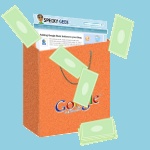Google Adsense is the most effective advertising network on the Internet, but it is also the strictest. One violation of its rules and you get kicked out of the ad network that monetizes the maximum number of websites and blogs. Once banned, Adsense won’t accept you back, ever!
Every month a large number of Adsense accounts get disabled. Most of them are small publishers who have just started using this tool. Generally, their websites lack the kind of traffic required to earn respectable money through Adsense. But everyone wants to get rich fast! In the process they tend to overlook the rules of playing the game.
If you are a website owner or blogger who has just started using Adsense, or want to implement the tool soon, you must get the rules right. Several online forums are full of threads where people complain about their Adsense application being rejected or worse, their account being disabled due to illegal activity or violation of terms. You don’t want to be one of them, do you?
Golden rules for Adsense
As a web publisher who is seriously looking at making money (legally) through websites, you would like to know the rules to abide by for success with Adsense. All of them boil down to having a website that is informative and useful, safe for family and does not try to trick visitors.
- Never click on your own ads: Adsense charges advertisers for every legitimate click generated by website visitors who are interested in advertisements. Neither advertisers nor Adsense would like to pay web publishers for clicking on their own ads as this doesn’t serve the purpose of placing ads on your website. Adsense check the clicks generated from your website and can easily detect click frauds. Such accounts are disabled and any money in the account is returned to advertisers.
- Don’t ask others to click on ads: Requesting friends and family members or website visitors to click on ads is also not allowed. Do so if you want to get banned.
- Don’t use black SEO: Search engine optimization is a must, but don’t use black tricks such as keyword cloaking (stuffing webpages with keywords) or buying links. Before making any change to your website or blog, ask the question: “Is it going to improve the usability of the website and add value for the visitors?” If not, don’t do it. Google wants good and useful websites that its visitors will find helpful. No spammy content, please.
- Don’t add prohibited content: Adsense requires websites to be of high quality and suitable for every one in the family. It does not allow websites related to gambling, pornography, adult content and drugs, among others. Also, avoid linking to websites with such content. Google does notify you if the ads are placed by mistake, but make sure that it doesn’t happen repeatedly.
- Don’t get illegal referrals: Websites are required to use legit ways of promotion. You cannot get visitors through Pay Per View or Paid To Click networks. Also, promotional links from pornographic or drugs websites is not allowed. Adsense also does not allow placing ads on webpages that are served through pop-ups. If you want to advertise your website, do so through Adsense or similar networks. Advertise on websites that fulfil Adsense account requirement. (They don’t need to have Adsense account, just be eligible for one.)
- Don’t tamper with Adsense code: Google allows only premium publishers to make changes to Adsense codes. As a regular publisher, you can customize the display (fonts, size, colour, links, etc.) of ads on the Adsense website. Once done, copy and paste the code as it is. Many publishers try to look “premium” by tweaking the code using javascript and CSS. Modify the code only if you are not bothered about being banned.
- Don’t disguise ads: Trying to pass advertisements as regular links is in violation of Adsense policy. Tricking your visitors by disguising ads as regular content may increase the number of ad clicks (click through rate, or CTR) but will get recorded as illegal clicks. Placing the ads under headers such as “Earn Money”, “Free Resources”, “Download Movies”, etc., is also another way of tricking visitors to click on advertisements. Google allows you to label ads as “Sponsored Links” or “Advertisements”. This way visitors know what the links are and will click them only if they are genuinely interested.
- No ads on pop-ups: If your website has pop-ups, do not place ads on those pages. Ideally, you should avoid having pop-ups on your website. Most often than not they are a nuisance for your visitors and Google also dislikes them.
- No ads from competing ad networks: Websites cannot place ads from other ad networks that use keywords to serve ads as Adsense does.
- Clear distinction between Adsense ads and other ads: If your website serves ads other than that from Adsense, you are required to make them easily distinguishable. Google does not want visitors to confuse other ads with its own and click them thinking it has been served by Google.
- No ads on pages that might get confused with Google: Adsense strictly prohibits placing ads on webpages which have Google trademarks, logos and other brand features in content or URL which could confuse users into thinking it is associated with Google.

